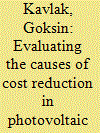| Srl | Item |
| 1 |
ID:
162346


|
|
|
|
|
| Summary/Abstract |
Photovoltaic (PV) module costs have declined rapidly over forty years but the reasons remain elusive. Here we advance a conceptual framework and quantitative method for quantifying the causes of cost changes in a technology, and apply it to PV modules. Our method begins with a cost model that breaks down cost into variables that changed over time. Cost change equations are then derived to quantify each variable's contribution. We distinguish between changes observed in variables of the cost model – which we term low-level mechanisms of cost reduction – and research and development, learning-by-doing, and scale economies, which we refer to as high-level mechanisms. We find that increased module efficiency was the leading low-level cause of cost reduction in 1980–2012, contributing almost 25% of the decline. Government-funded and private R&D was the most important high-level mechanism over this period. After 2001, however, scale economies became a more significant cause of cost reduction, approaching R&D in importance. Policies that stimulate market growth have played a key role in enabling PV's cost reduction, through privately-funded R&D and scale economies, and to a lesser extent learning-by-doing. The method presented here can be adapted to retrospectively or prospectively study many technologies, and performance metrics besides cost.
|
|
|
|
|
|
|
|
|
|
|
|
|
|
|
|
| 2 |
ID:
109684


|
|
|
|
|
| Publication |
2011.
|
| Summary/Abstract |
Solar power technologies will have to become a major pillar in the world's future energy system to combat climate change and resource depletion. However, it is unclear which solar technology is and will prove most viable. Therefore, a comprehensive comparative assessment of solar technologies along the key quantitative and qualitative competitiveness criteria is needed. Based on a literature review and detailed techno-economic modeling for 2010 and 2020 in five locations, we provide such an assessment for the three currently leading large-scale solar technologies. We show that today these technologies cannot yet compete with conventional forms of power generation but approach competitiveness around 2020 in favorable locations. Furthermore, from a global perspective we find that none of the solar technologies emerges as a clear winner and that cost of storing energy differs by technology and can change the order of competitiveness in some instances. Importantly, the competitiveness of the different technologies varies considerably across locations due to differences in, e.g., solar resource and discount rates. Based on this analysis, we discuss policy implications with regard to fostering the diffusion of solar technologies while increasing the efficiency of policy support through an adequate geographical allocation of solar technologies.
|
|
|
|
|
|
|
|
|
|
|
|
|
|
|
|